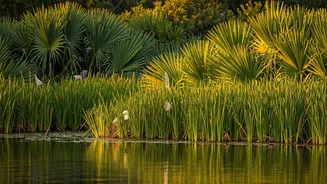Jim Corbett's Legacy
Jim Corbett National Park, situated in Uttarakhand, is India's oldest national park and a cornerstone of tiger conservation. Established in 1936, the park has
witnessed decades of dedicated conservation efforts, evolving from a game reserve to a sanctuary for tigers and a host of other species. The diverse ecosystem of Jim Corbett includes the Ramganga River and the Shivalik hills, providing a habitat for a multitude of flora and fauna. The park's significance in preserving India's tiger population, coupled with its historical importance, makes it a pivotal destination for both wildlife enthusiasts and historians, reflecting its enduring impact on conservation strategies and ecosystem protection. Visitors to the park have the chance to spot tigers, elephants, leopards, and various bird species, making it a thrilling destination for wildlife safaris. Its varied terrain, from dense forests to grasslands, provides varied habitats, contributing to a rich biodiversity.
Neora Valley's Allure
Neora Valley National Park, found in West Bengal, showcases an exceptionally diverse range of flora and fauna within its undisturbed natural environment. The park is renowned for its rich biodiversity, where visitors can encounter rare species like the red panda, various orchids, and a variety of vibrant birdlife. Its elevated geography offers breathtaking views, allowing trekkers and nature lovers to experience the serene beauty of the Eastern Himalayas. Neora Valley is a significant site for biodiversity conservation, offering researchers and ecologists critical insights into the region's ecosystem. The park provides an excellent example of nature's beauty and the need for rigorous conservation strategies, encouraging both biodiversity conservation and eco-tourism initiatives within the park's boundaries. Its dense, untouched forests are home to an array of plant and animal species, making it a crucial area for ecological studies and conservation efforts in eastern India.
Ranthambore's Majesty
Ranthambore National Park in Rajasthan, known for its majestic tigers, offers incredible opportunities to observe these creatures in their natural habitat. The park is home to a varied collection of wildlife, including leopards, deer, and many bird species, against the backdrop of ancient forts and serene lakes. This blend of natural beauty and historical significance provides a distinct and engaging atmosphere for visitors. The historical ruins and the captivating beauty of the landscape enrich the safari experience, providing a striking contrast to the lush wilderness. Ranthambore is essential to tiger conservation in India, with rigorous conservation initiatives playing a crucial role in safeguarding tiger populations. The park's historical setting, combined with its wildlife, attracts both wildlife enthusiasts and history lovers, making Ranthambore a significant landmark for Indian tourism.
Kerala's Periyar Sanctuary
Periyar Wildlife Sanctuary, located in Kerala, provides an immersive wildlife experience and stunning landscapes amidst the Western Ghats. The sanctuary, centered around the Periyar Lake, offers stunning scenery and supports various species, like elephants, tigers, and a wide variety of birds. Boat safaris on the lake provide a unique way to observe wildlife, with opportunities to see animals coming to drink and bathe. This sanctuary is key to environmental protection, and it is a popular spot for both local and foreign tourists because of its diverse ecosystem and panoramic landscape. Periyar's commitment to eco-tourism and wildlife preservation makes it an important center for sustainable tourism and environmental conservation. Visitors can enjoy not only wildlife sightings but also the serene environment and the natural beauty of the area.
Kanha's Lush Wilderness
Kanha National Park in Madhya Pradesh is renowned for its lush sal and bamboo forests, and it is a major landmark in tiger conservation. This park, which inspired Rudyard Kipling's 'The Jungle Book,' supports a diverse variety of animals, including the tiger, leopard, sloth bear, and Indian wild dog. The vast grasslands and dense forests create a perfect habitat for different species, promoting the natural preservation of biodiversity. Kanha’s well-managed ecosystem and conservation initiatives help to protect species and encourage ecological preservation. The park's commitment to eco-tourism guarantees that visitors have a memorable experience while still safeguarding the environment. Visiting Kanha offers wildlife enthusiasts and nature lovers a chance to discover India's rich biodiversity, and it is essential for the preservation of endangered species.
Valley of Flowers' Bloom
Valley of Flowers National Park, found in Uttarakhand, is a UNESCO World Heritage Site, famed for its mesmerizing alpine flower meadows. This beautiful national park is home to a variety of endemic flowers, including vibrant orchids, primulas, and daisies, which create a stunning floral landscape. The valley's stunning scenery, combined with the biodiversity of the area, attracts trekkers and nature enthusiasts from across the globe. The best time to visit the Valley of Flowers is during the monsoon months when the meadows are in full bloom, revealing a vibrant carpet of colors. Because of its beauty and importance to biodiversity, the park is a popular spot for both research and tourism. The park's significance in preserving India's alpine ecosystems further establishes its importance.
Sundarbans' Mangrove Marvel
Sundarbans National Park in West Bengal is the world's largest mangrove forest and home to the majestic Royal Bengal tiger. The park, situated at the confluence of the Ganges, Brahmaputra, and Meghna rivers, is an important ecosystem supporting a unique variety of species adapted to the saline environment. Boat safaris offer an exceptional way to observe the tigers and other wildlife, including various bird species and aquatic animals. The Sundarbans is a UNESCO World Heritage site and an important site for biodiversity conservation. Its role in protecting the Bengal tigers and the significance of the mangrove ecosystem underlines its ecological and cultural significance. The park's remote location and natural beauty make it a must-visit destination for wildlife enthusiasts and environmentalists.
Gir's Asiatic Lions
Gir National Park in Gujarat is the only natural habitat for the Asiatic lion, offering a unique opportunity to see these majestic animals. The park's preservation efforts have turned the area into a protected sanctuary for the lions and a haven for other species, like leopards, sambar deer, and various bird species. The park’s dry deciduous forests and diverse landscape provide a perfect environment for a variety of wildlife. The conservation efforts at Gir have been incredibly successful, with the lion population steadily increasing over the years. This park is an important destination for wildlife lovers, offering a rare opportunity to observe these majestic animals in their natural habitat. Gir National Park is also a great example of successful conservation and is a very important landmark for wildlife protection in India.
Kaziranga's Rhinos
Kaziranga National Park in Assam is recognized for its significant one-horned rhinoceros population and its amazing biodiversity. The park's vast grasslands, lush wetlands, and dense forests support a wide variety of species, including elephants, tigers, and a wide range of bird species. The Brahmaputra River flows through the park, helping to create a productive ecosystem that supports a range of animal and plant life. Kaziranga has a long and successful history of conservation, turning it into a protected habitat for the rhinos and other wildlife. Its commitment to ecological balance makes it a highly significant conservation area. The park's status as a UNESCO World Heritage site and its thriving rhino population add to its cultural and ecological importance, making it a must-visit location for nature lovers.
Plan Your Adventure
These ten national parks represent a tiny fraction of India's remarkable natural heritage, and each one offers a unique and memorable experience. Visitors are encouraged to research these parks, consider their interests, and make plans to visit them while respecting the environment. Every park offers a chance to see India's rich biodiversity and witness the country's continuing conservation efforts. Planning a trip to these amazing places is an opportunity to appreciate the country’s natural wonders while supporting the preservation of these areas. These locations promote not only natural beauty but also ecological education and responsible tourism.













